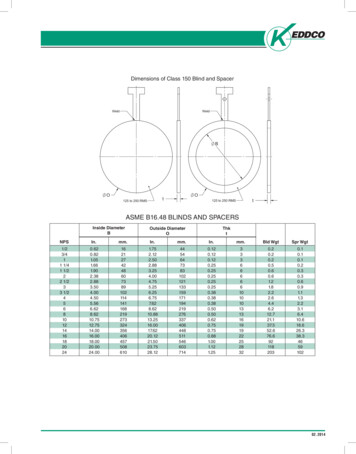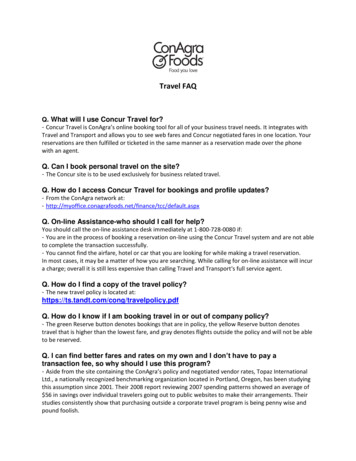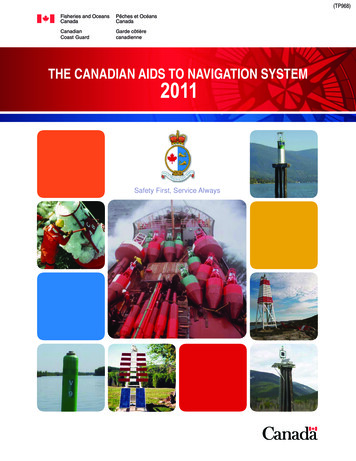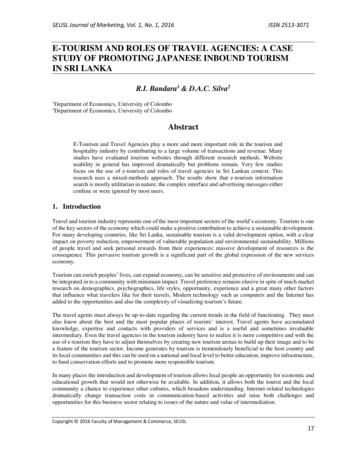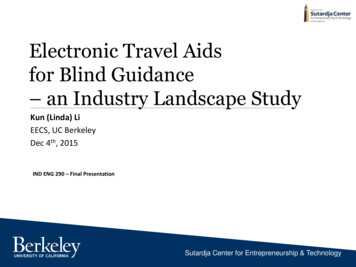
Transcription
Electronic Travel Aidsfor Blind Guidance– an Industry Landscape StudyKun (Linda) LiEECS, UC BerkeleyDec 4th, 2015IND ENG 290 – Final PresentationSutardja Center for Entrepreneurship & Technology
Visual ImpairmentTraditional travel aids arelimited, invasive, trainingheavy, and not social friendly Globally 285M/7.3B with VI, 39M blind– 90% live in low income settings– Incomplete public facilities indeveloping countries US 10M/320M with VI, 1.3M blind– 109K VI use white canes (1.1%)– Just over 7K VI use dog guides (0.07%)Sutardja Center for Entrepreneurship & Technology
Electronic Travel Aids (ETA)Sensors Functions: obstacle detection,mapping and navigation Signals received: acoustic,electrical, optical, etc. Signals translated: auditory,tactile cues, stereophonicimageSutardja Center for Entrepreneurship & Technology
Existed / Existing Products Ultrasonic Sensor (Sonar)(Primary reference: Vance Landford, “Electronic travelaids ETAs, past and present,” TAER April 2004.)(Image courtesy: S. Shoval et al, IEEE Tran. on Syst., 1998)Sutardja Center for Entrepreneurship & Technology
Type-ISingle output for objectpreview, go-no-go system,secondary 66-NA1.83 mNAUltrasonicCone, Mowat1972-NA4.02 mNAPolaron, Nurion1980-NA?4.88 m 892Sensory 6NA-19942-3.5 mNAHead positionimportantWalkMate1993-NA1.83 mNABeam may varyoutdoorMiniguide US2004-Now7.92 m 545Bad weatherfailureSutardja Center for Entrepreneurship & Technology
Type-IIMultiple outputs forobject preview, go-no-gosystem, secondary aid orprimary tool ionNA2.44mforward,1.22mabove head,0.3m side,2.44m dropoffs 4500Laser Cane N2000StillAvailable3.66m3 beams(straight,head, drop) 2650Guide CaneNA-19983.5mBAT ‘K’CaneHandleNA-2003Ultra CaneAvailable2 or 4mforward, 1.6mabove headDemo 635Sutardja Center for Entrepreneurship & Technology
Type-IIIObject preview, plusenvironmental information,giving text rather thanheadlines! Dr. Leslie Kay– Type-I, Ultra Sonic Torch,1965, 1st ETA product– Type-II, BAT ‘K’Cane Handle– Type-III Sonic Guide The concept of Type-III ETA– Interpretation of tonalcharacteristics makingprimitive object identificationpossibleSutardja Center for Entrepreneurship & Technology
Type-IVObject preview, plusartificial intelligence Sonic Pathfinder– Computer translates sonic energy todirectional music notes– Displays only information of practicalinterest, not visual picture of world– Secondary aid, less training– Not commercialized, research in 1996http://members.optuszoo.com.au/aheyes40/pa/pf blerb.htmlSutardja Center for Entrepreneurship & Technology
Limitations of currentsonar-based productsCurrent available products arestill secondary aids for awhite cane or guide dog Limited range ( 5m) and resolution( 3cm) Slow response, not for fast walking Acoustic interference and screening Large divergence, not directional No precise information about shapeand motion status of obstaclesMini-guide US 545UltraCane 635Laser Cane 2650Special “sonar”Sutardja Center for Entrepreneurship & Technology
State-of-the-art Research Infrared Sensor Camera– CCD or CMOS– Stereo Camera– Projected-light Camera 3D LiDARSutardja Center for Entrepreneurship & Technology
Infrared SensorIn addition to distance, itprovides material recognitionand shape analysis Mechanism – triangulation Range: 10cm-1.5m with 93%accuracy Response time: 39ms comparedwith 100-200ms for sonar(Reference: A.S. Al-Fahoum, et al, “A smartmicrocontroller-based blind guidance,” Hindawi, 2013)(Image ion/infraredlight.cfm)Sutardja Center for Entrepreneurship & Technology
CCD or CMOS CameraWhen webcam meets neuroscience- a whole sound picture, notjust go-no-go, to truly improvequality of life vOICe!!!– Neuroscience: neural crossmodalplasticity– vOICe software does image-to-soundrendering, through crossmodalsensory integration– Creates stereophonic effect,acoustic panorama– Drawbacks: limited ranging ability(check out their website for demos and papers:https://www.seeingwithsound.com/)Sutardja Center for Entrepreneurship & Technology
Stereo CameraCamera with depth information,but limited Two lenses and sensors tosimulate human binocularvision, but not as good as oureyes!(Reference: V. Pradeep, et al, “Robot vision for thevisually impaired,” IEEE confer. 2010)Sutardja Center for Entrepreneurship & Technology
Projected-light3D CameraCombining the projection of alight pattern with a standard2D camera 2D cameras: stereo or RGB Depth information: patterned light,triangulation Available products––––Ensenso N10Microsoft Kinect (0.7-3.5m)Asus XtionApple PrimeSense Carmine (0.35-1.4m) Drawbacks: limited range, not suitablefor outdoorSutardja Center for Entrepreneurship & Technology
3D LiDAR CameraLaser “Radar”, time of flight (ToF)ProductCompany Need a “compromised”LiDARcamera at cheaper price!ApproachRangeFoVResolutionPriceSwiss Ranger4000HeptagonModulated5-8m176x14 pixel43.6 x 34.6 9KCamCube 2.0PMD Tech.-7m204x204 pixel40 x 40 12KPuckVelodynePulsed,scanner100m-360 x 30 8KTigerCubASC3DPulsed,flash 1km-- 50KLiDAR-Lite 2PulsedLightPoint-wise40m1cm- 11510m1x1 ppi40 x 40 ?Sth inbetween?Sutardja Center for Entrepreneurship & Technology
Projection Global LiDAR market is expectedto reach 624.9M by 2020 285M vision-impaired people,and it will make their lives alot better! Autonomous cars and roboticsmarkets to lead Moore’s lawfor LiDAR?Sutardja Center for Entrepreneurship & Technology
Thank you! Email: IDAR-Lite 2Sutardja Center for Entrepreneurship & Technology
Heptagon Modulated 5-8m 176x14 pixel 43.6 x 34.6 9K CamCube 2.0 PMD Tech. - 7m 204x204 pixel 40 x 40 12K Puck Velodyne Pulsed, scanner 100m 360- x 30 8K TigerCub ASC3D Pulsed, flash 1km - - 50K LiDAR-Lite 2 PulsedLight Point
